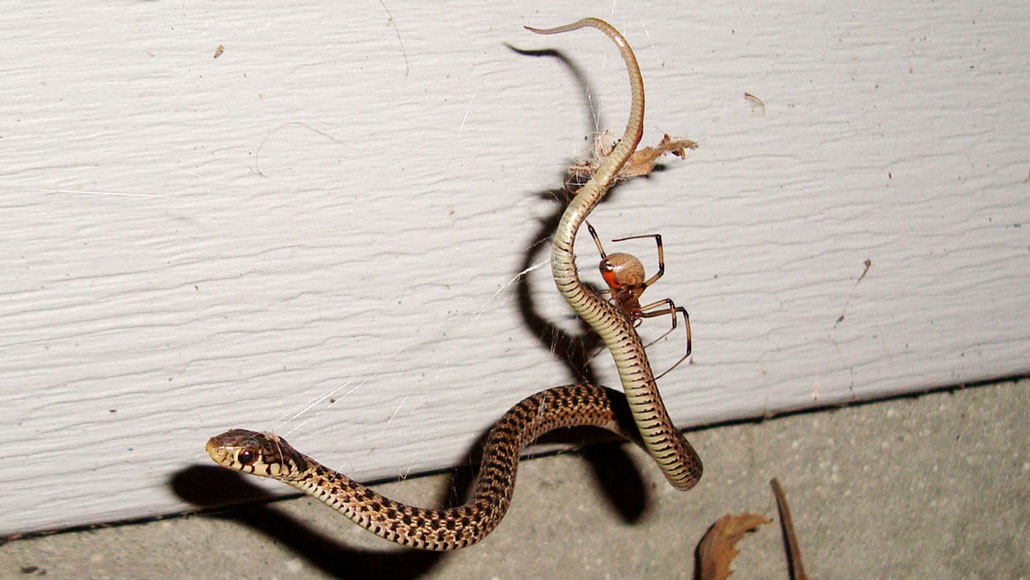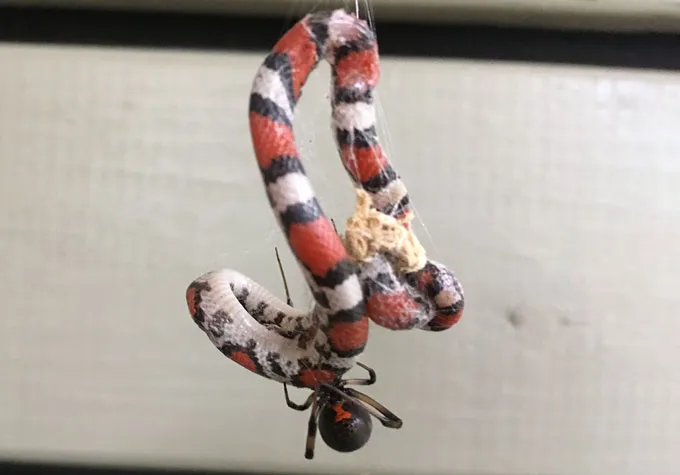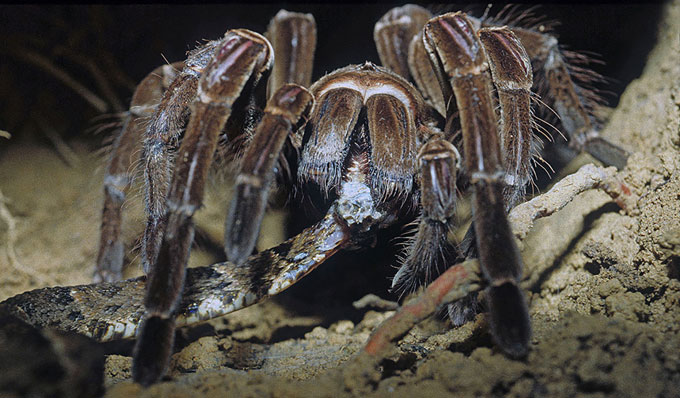Snake-eating spiders are surprisingly common
Spiders from at least 11 different families feed on serpents many times their size

A brown widow spider (Latrodectus geometricus) inspects a common garter snake (Thamnophis sirtalis) trapped in its web.
Julia Safer
By Asher Jones
- More than 2 years ago
Read another version of this article at Science News Explores
A spider’s typical dinner menu might include insects, worms or even small lizards and frogs (SN: 2/3/21). But some arachnids have more adventurous tastes — they can eat snakes up to 30 times their size.
Take the Australian redback. Not including legs, a female of this species of spider is only about the size of an M&M candy. But she can take down relatively big prey such as juvenile eastern brown snakes, which are among the most venomous serpents in the world. A snake that gets trapped in a redback’s web — a messy tangle of long, sticky silk threads that dangle to the ground — is quickly set upon by the spider, which subdues the struggling victim with more sticky silk before delivering a toxic bite that eventually kills the snake.
“I find it cool that tiny Australian redback spiders can kill brown snakes,” says spider biologist Martin Nyffeler of the University of Basel in Switzerland. “[It’s] very fascinating and a little frightening!”
But redbacks are far from the only spiders with an appetite for snake. At least 11 different families of spiders feed on snakes, Nyffeler and herpetologist Whit Gibbons report May 11 in The Journal of Arachnology.

Nyffeler and Gibbons, of the University of Georgia in Athens, searched for reports of snake-eating spiders in all sorts of places — from research journals and magazine articles to social media and YouTube videos. In all, the team analyzed 319 accounts from all over the world. Most reports came from Australia and the United States, but these spiders live on every continent except Antarctica.
“I didn’t realize how common this was. I don’t think anybody did,” says evolutionary biologist Mercedes Burns of the University of Maryland, Baltimore County, who was not involved in the research.
Snakes that the spiders ate came from seven families. Some, including coral snakes, rattlers, palm-pitvipers and lanceheads, are highly venomous. “I was kind of surprised at the types of snakes that were described because some of them are pretty big, pretty strong,” Burns says.
Tangle web spiders, a group that includes North American widow spiders and redbacks, are the most successful snake slayers, Nyffeler and Gibbons found. Relatively small, these spiders can catch snakes 10 to 30 times their size, Nyffeler says.
Tidier orb weaver spiders don’t do too shabbily either (SN: 8/3/20). A golden silk orb weaver in Florida caught a 1-meter-long green snake, the longest in the study. However, making a meal of green snakes may be a risky choice — these serpents often eat arachnids, including orb weaver spiders, the researchers say.
Not all snake-eating spiders trap the serpents with webs. Tarantulas actively hunt their prey, then use powerful jaws to deliver a potent venom (SN: 2/28/19). “Often a tarantula tries to catch the snake by the head and will hold on in spite of all efforts of the snake to shake him off,” Nyffeler says. Once that venom takes effect, the snake calms down.
In some encounters, venom defeated snakes in minutes. In others, spiders took days to kill their prey, Nyffeler and Gibbons found.

Once the snakes die, spiders use enzymes to turn soft body parts into a soup that the arachnids suck into their stomach. “They have what’s called a pumping stomach,” Burns says. “It’s almost like their stomach is attached to a rubbery straw. They have to kind of suck everything down.”
Most of spiders in the study likely dine on snake only now and again, Nyffeler says. Some South American tarantulas, however, eat snakes and frogs almost exclusively.
Nyffeler hopes that his new study increases appreciation for spiders, which he calls extraordinary creatures. “The fact that small spiders are capable of killing much larger snakes is very fascinating,” he says. “Knowing and understanding this enriches our understanding of how nature works.”






